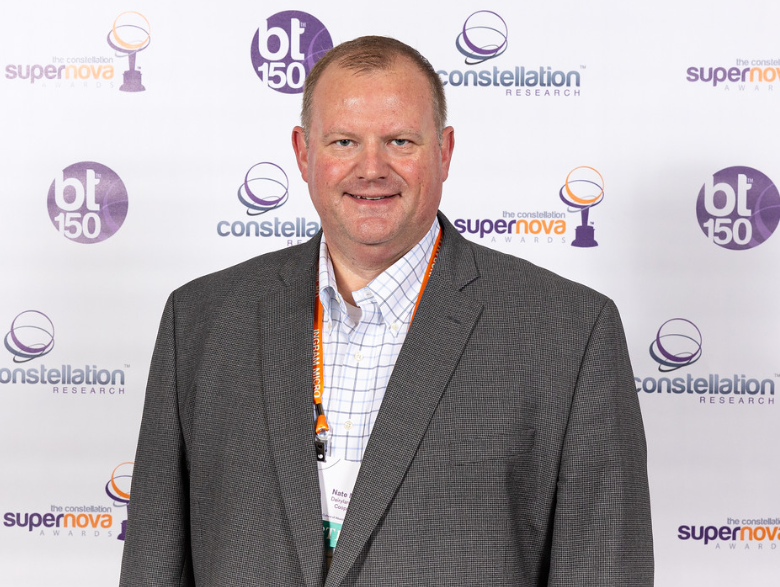Dairyland Power Cooperative, a La Crosse, Wis., is a utility designed to serve rural areas and supply power to customers in four states. It also sits in the middle of multiple trends including energy transition, sustainability and the convergence of information and operational technologies.
I caught up with Nate Melby, Chief Information Officer of Dairyland Power Cooperative, to talk utilities, transformation and IT. Melby is a Business Transformation 150 member.
Transformation and utilities. Melby said utilities are going through a massive transformation that extends from back-office, customer experience to the technology in the field. Operational technology is where the action is. Melby said:
"Not only are we transforming our information technology world, but we’re also transforming those operational technologies. We're in the middle of an energy transition. We're seeing the sources of our generation change and as we add more renewables to the grid, increased complexity creates some new use cases and new scenarios. We have to manage it all and try to do it at scale."
Renewable challenges. "One of the challenges is that the sun doesn't shine all the time, and the wind doesn't blow all the time. And our utilities in the Upper Midwest have extreme weather conditions. Winters are very cold," explained Melby. "How do we continue to sustain the right type of generation for the load that we have across our utility and make sure that we're resilient in the event of those extreme weather conditions?"
With renewables the technology behind the grid has to be smarter and nimbler. The evolution of the smart grid will have to evolve to be more real-time with data about power generation and overall performance. Melby said:
"You had a power plant that would run, and you could control that, but it would run in a steady state. With renewables, you have changes in real time. A cloud goes over a solar array, and the generation drops off for a certain period. We need to be able to control very quickly, and it's not a 15-minute decision in the future, but maybe real time interaction. We see opportunities for machine learning and artificial intelligence to apply that to those problems. There's some potential for us to automate that decision making to provide better control and more resilience."
When will this smart grid arrive? Melby said the smart grid concept is coming in faster than the industry is prepared for just because of demand and need. "We're seeing integration on the power grid before we even have a notion of a virtual power plant and what that could mean. Connecting different types of generation resources in a way we can predict and scale up and down generation with storage and renewables is critical," said Melby.
Digital twins and the grid. Melby said he sees "huge potential for digital twins in our industry." These digital twins could replicate multiple power plants and energy sources so utilities could understand proactive maintenance and the impact of decisions. "Multiply that example by fleet, add the renewables and you can essentially create a virtual model to predict your future performance," he said.
Are the data strategies in place to create virtual power plants? "It's a heavy lift, but one of the advantages of the utility space is that historical data and the capturing of historical data has always been something we've had to do," said Melby, who noted that utilities are regulated to keep 10 years of data. "We have really good foundational data, datasets and data structure. Leveraging that for the future is really about data governance. How do we build the right architecture and the right structure to leverage that data?"
Melby said the historical data at 15-minute and 5-minute intervals are useful, but the future grid will produce "an explosion of data points." "We're seeing exponential growth in data and that means an exponential growth in the data that we have to store. We will need platforms to manage all of that," he said.
Regulation, compliance and security. Melby said regulation, compliance and security has typically meant that utilities kept control of data in closed systems. AS a result, cloud computing has been used on the corporate side but not in operations. Melby said:
"We're now starting to see areas like energy management systems where the cloud is becoming part of it. The cloud architectures have to be built through the lens of managing security and compliance boundaries. Cloud adoption starts with energy management systems, and then distributed energy resource management, and the challenge is how you integrate operations of utilities across regions."
Efficiency and use cases. Melby said utilities are really about efficiency and improving business cases so they can operate at a lower cost and lower rates. "Our mission is to have the lowest rates possible, so we make decisions based on that," he said. Use cases to advance efficiencies revolve around weather prediction, proactive maintenance and managing resources.
Sustainability also overlaps with efficiency. Melby said.
"Sustainability is one of our largest goals. It intersects with technology, efficiency, and the data that we need to effectively manage the grid. Sustainability for us is also about the sustainability of our utility for the people that need us. We provide power in rural areas. We were created to solve the quality-of-life issue where it couldn't be profitable to provide power to rural areas. Our whole mission is to provide power at the lowest cost possible as efficiently and into the future with diverse resources. It's evolving as our industry has been changing, and we're seeing this energy transition happen."


